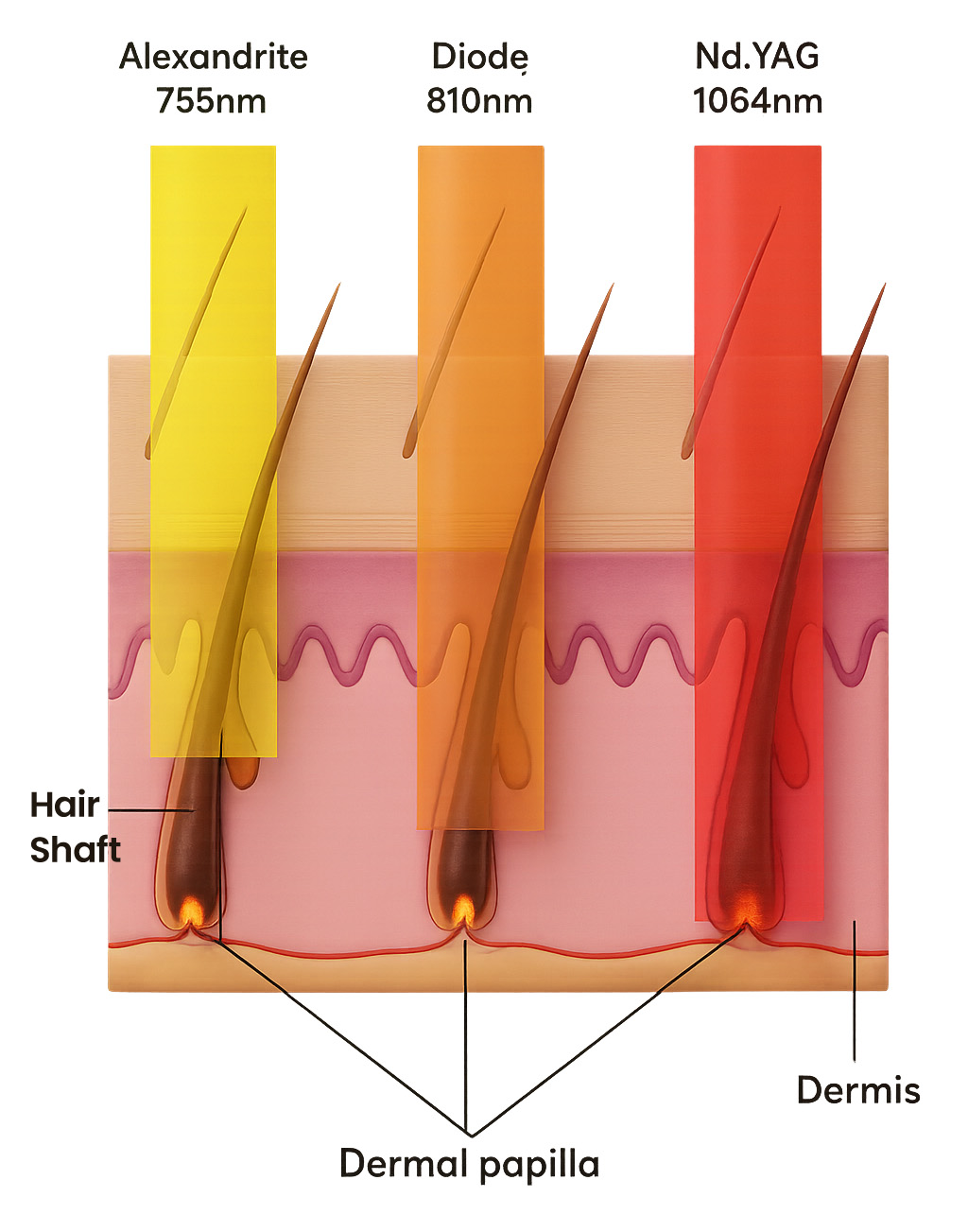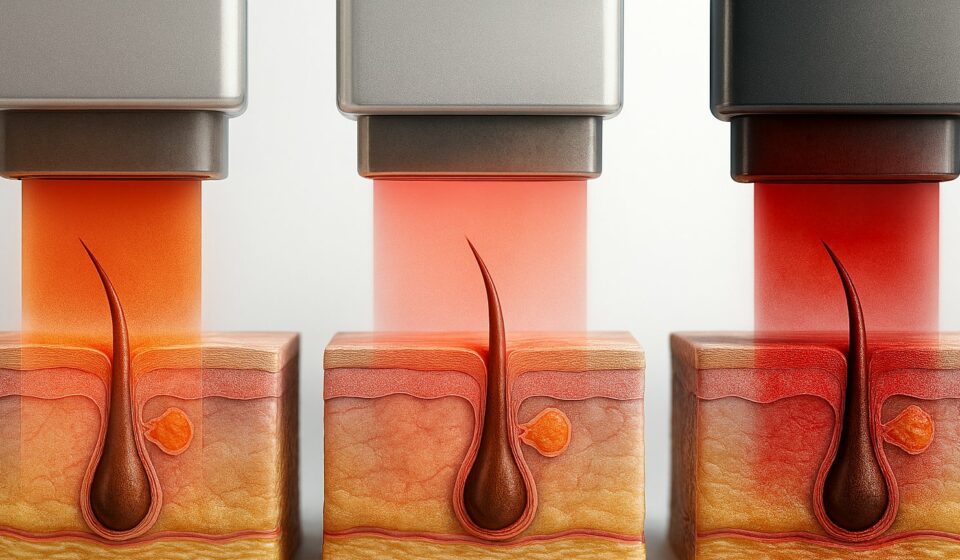In clinic practice there are three primary laser types for hair removal: Alexandrite at 755 nanometres, Diode at about 800 to 810 nanometres, and Nd:YAG at 1064 nanometres. Each behaves differently in skin and hair, which is why many clinics now choose three in one platforms.
Table Of Content
What makes a laser effective for hair removal
- Selective photothermolysis: light energy targets melanin in the hair shaft, converts to heat, and disables growth structures while sparing nearby skin. A clear, accessible explainer is available from the Mayo Clinic.
- Depth of penetration: longer wavelengths travel deeper, helpful for coarse, deeply rooted hair and richer skin tones.
- Epidermal protection: cooling at the tip keeps the surface comfortable, allowing therapeutic energy to reach the follicle.
The main laser types used in clinics
| Laser type | Typical wavelength | Best fit | Key strengths | Watch outs |
|---|---|---|---|---|
| Alexandrite | 755 nm | Skin I to III, fine to medium hair | High melanin absorption, very fast on large areas | Use careful settings on darker tones to avoid pigment change |
| Diode | 800 to 810 nm | Skin I to V, medium to coarse hair | Versatile depth, strong data, widely adopted in UK clinics | For the darkest tones, YAG often provides a wider safety margin |
| Nd:YAG | 1064 nm | Skin IV to VI, coarse or deep follicles | Deep penetration with lower melanin absorption at the surface, safer window for dark skin | May require more sessions or higher fluence for fine hair |
| Ruby (historical) | 694 nm | Very light skin, fine hair | Strong melanin absorption | Rare today due to higher pigment risk and slower repetition |
| IPL (not a laser) | Broad spectrum with filters | Skin I to III typically | Multi use device for hair and skin rejuvenation | Less selective than lasers, caution for darker tones |
01. Alexandrite at 755 nm
- Where it shines: fast coverage and strong response on fair to medium skin with fine to medium hair. The shallow to mid depth absorption profile makes it a favourite for legs and arms.
- Technique tips: match spot size to target depth, maintain chilled contact cooling and use test patches when treating tan prone skin.
02. Diode at about 810 nm
- The workhorse: widely used across UK clinics, with diode platforms holding around forty percent share of the market according to Grand View Research.
- Why clinics love it: balanced absorption and depth, reliable reduction across many body sites, strong performance for medium to darker hair colours on lighter to medium skin.
03. Nd:YAG at 1064 nm
- Safest window for dark skin: the longer wavelength passes past epidermal melanin, so it is the preferred choice for Fitzpatrick IV to VI when used by trained practitioners.
- Great for deep, coarse hair: backs and beards often respond well, though fine hair may need careful parameter selection.

How modern machines combine these lasers
Smart platforms deliver all three wavelengths in one system, then add contact cooling, stable energy at higher repetition, and intelligent presets. Market commentary points to continued improvements in targeting and comfort with features such as AI guided analysis and next generation cooling, as noted by Future Market Insights.
- Nu TriLaze Plus: three wavelengths, built in skin analyser and interchangeable tips for detailed facial work. See Nu TriLaze Plus.
- Nu eRays Plus: three wavelengths with handpiece controls for fast adjustments chairside, FDA approved safety, rapid UK support. Explore Nu eRays Plus.
- Nu TriLaze Lite: compact three in one with SuperCool technology and very low running cost, perfect for mobile teams or multi room setups. Details at Nu TriLaze Lite.
Matching laser type to client profile
- Lighter skin, fine to medium hair: Alexandrite offers brisk sessions and crisp reduction.
- Mixed tones, varied hair calibre: Diode provides a versatile middle ground for many body areas.
- Darker skin, coarse hair: Nd:YAG gives the safest margin at the surface with effective depth.
- Why many clinics choose three in one: you can personalise wavelength and pulse width per area, then keep comfort high with strong cooling. For a quick primer on skin and hair contrast, see this accessible discussion of melanin and wavelength choice on Removing Hair.
Safety, training and next steps
- Licensing and compliance: England is moving to mandatory licensing for non surgical cosmetic procedures, including laser hair removal, as set out on GOV.UK.
- Training with certification: we include Core of Knowledge and device training with a certificate that supports insurance and local authority checks.
- Laser Protection Advisor support: our Laser Protection Advisor service helps with risk assessments, eyewear protocols and safe room setup.
04. Explore, compare and plan
- Compare our range: view all three in one systems on laser hair removal machines, then book a demo in Coventry or online.
- Read next: Which type of laser is best and How safe is laser hair removal.
Bottom line: Alexandrite, Diode and Nd:YAG each offer distinct strengths. A three in one platform lets you deploy the right wavelength for the right client every time, with comfort, speed and safety built in.
Dr Majid Zarandouz
Majid holds a PhD in organic chemistry and has been working with laser systems for decades. His career began in the mid-1990s, when he started researching and developing laser-based technologies for medical and cosmetic applications. Over the years, he has combined scientific expertise with practical engineering to design machines that are effective, durable, and straightforward to use in real clinic settings. As director of the British Institute of Lasers, Majid continues to focus on producing equipment that meets professional standards while remaining accessible to businesses of all sizes.

